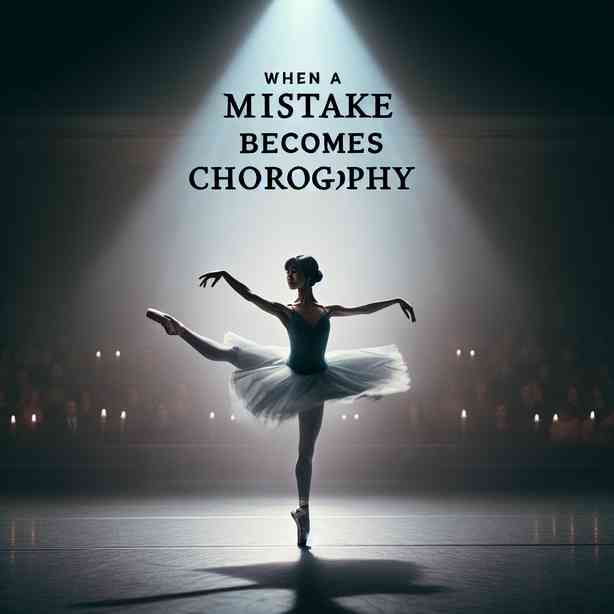
When a mistake becomes choreography, it opens up a fascinating perspective on creativity and the artistic process. Mistakes, often seen as failures or errors, can lead to unexpected innovations and breakthroughs, allowing individuals to tap into their true potential. This exploration of imperfections can be especially relevant in fields such as dance, music, visual arts, and even daily life.
In the realm of dance, choreographers and dancers alike frequently encounter moments where their movements don’t go as planned. These unintentional deviations from the intended choreography can result in unique expressions of movement that might never have emerged in a perfectly executed performance. For instance, a dancer might lose balance and stumble, but instead of collapsing into a failed performance, they might incorporate that stumble into the dance, transforming it into a fluid and beautiful sequence. This ability to adapt, to turn an unforeseen mistake into a new form of expression, is at the heart of innovative choreography.
Many renowned choreographers have embraced this approach. They often advocate for a creative process that prioritizes exploration and the acceptance of errors as part of the journey. Instead of rigidly adhering to pre-established forms, they encourage dancers to find freedom in their movements, allowing spontaneity and authenticity to guide their performance. This philosophy not only enriches the choreography but also cultivates a deeper connection to the art form itself, emphasizing the beauty of raw, unrefined expression.
Beyond the world of dance, this concept can also be applied to various forms of art. In visual arts, artists frequently experiment with techniques that may result in unintended effects. The splatter of paint may seem like a mistake, but when viewed from a different perspective, it can become the focal point of a stunning piece of art. Artists who embrace these happy accidents often create work that resonates deeply with viewers, showcasing a layered understanding of both control and release.
In music, improvisation is a perfect example of how mistakes can lead to extraordinary creativity. Jazz musicians often rely on their ability to adapt and innovate in the moment, creating melodies that resonate with emotion and spontaneity. A missed note may serve as a springboard for a new direction in a performance, leading to an unforgettable musical experience. The interplay between structure and freedom in music exemplifies how embracing mistakes can result in memorable and original compositions.
The beauty of this approach lies in its application beyond the arts, extending into our everyday lives. In our personal and professional endeavors, mistakes can often serve as valuable learning experiences. When faced with challenges or unexpected outcomes, one can choose to view these moments not as failures, but as opportunities for growth. This shift in mindset fosters resilience and creativity, allowing individuals to navigate life’s complexities with greater agility and innovation.
Furthermore, the culture of perfectionism prevalent in many societies often stifles creativity and courage. Many people fear making mistakes and, as a result, hesitate to take risks. However, recognizing that mistakes can lead to growth and inspiration empowers individuals to embrace uncertainty. This shift can encourage people to step outside their comfort zones, leading to new ideas and ventures that they may have previously deemed unattainable.
The process of transforming mistakes into choreography is also deeply connected to the notion of vulnerability. When we allow ourselves to expose our imperfections, we open the door to authenticity. Authenticity in art and life fosters deeper connections with others, as audiences and peers relate to the shared experiences of struggle and discovery. The stories behind the mistakes become valuable narratives, enriching both the creator’s journey and the observer’s experience.
Embracing mistakes as part of the creative process can also cultivate a more profound appreciation for the work of others. When we understand that behind every polished performance or beautiful piece lies countless attempts, challenges, and so-called ‘mistakes,’ we develop empathy for the artists’ journey. It encourages admiration for their tenacity and ability to find beauty in the imperfections of their craft.
As we conclude this exploration of how mistakes can transform into choreography, it is essential to remember that the arts, much like life itself, are not about achieving perfection but about the journey of expression and discovery. Embracing our mistakes allows us to break free from the constraints of expectation, fostering genuine creativity that reflects our individuality. By understanding that every stumble can lead to a new dance, we create a space where innovation thrives, inviting us to dance through life with authenticity, courage, and grace.
Ultimately, when a mistake becomes choreography, we are reminded that the beauty of creativity lies not only in the final performance but also in the myriad experiences that shape it. Each misstep, each change in direction, contributes to a unique artistic footprint that tells a story of resilience, innovation, and the unyielding human spirit. Let us continue to dance with our mistakes, turning them into beautiful choreography that resonates with the world around us.


